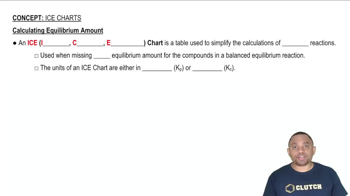At 218°C, 𝐾𝑐 = 1.2×10−4 for the equilibrium NH4SH(𝑠) ⇌ NH3(𝑔) + H2S(𝑔) (a) Calculate the equilibrium concentrations of NH3 and H2S if a sample of solid NH4SH is placed in a closed vessel at 218°C and decomposes until equilibrium is reached.
Ch.15 - Chemical Equilibrium
Chapter 15, Problem 52a
At 80°C, 𝐾𝑐 = 1.87×10−3 for the reaction PH3BCl3(𝑠) ⇌ PH3(𝑔) + BCl3(𝑔) (a) Calculate the equilibrium concentrations of PH3 and BCl3 if a solid sample of PH3BCl3 is placed in a closed vessel at 80°C and decomposes until equilibrium is reached.
 Verified step by step guidance
Verified step by step guidance1
Write the balanced chemical equation for the reaction: PH3BCl3(s) ⇌ PH3(g) + BCl3(g).
Set up an ICE (Initial, Change, Equilibrium) table. Since PH3BCl3 is a solid, its concentration does not appear in the expression for Kc. Assume initial concentrations of PH3 and BCl3 to be 0 M.
Let x be the change in concentration of PH3 and BCl3 as PH3BCl3 decomposes. At equilibrium, the concentrations of PH3 and BCl3 will both be x M.
Write the expression for the equilibrium constant, Kc, in terms of x: Kc = [PH3][BCl3]. Substitute the equilibrium concentrations into this expression to get Kc = x^2.
Solve the equation Kc = x^2 for x to find the equilibrium concentrations of PH3 and BCl3. Use the given value of Kc = 1.87×10−3 to find the value of x.

Verified video answer for a similar problem:
This video solution was recommended by our tutors as helpful for the problem above.
Video duration:
1mWas this helpful?
Key Concepts
Here are the essential concepts you must grasp in order to answer the question correctly.
Equilibrium Constant (Kc)
The equilibrium constant (Kc) is a numerical value that expresses the ratio of the concentrations of products to reactants at equilibrium for a given reaction at a specific temperature. For the reaction PH₃BCl₃(s) ⇌ PH₃(g) + BCl₃(g), Kc = [PH₃][BCl₃] / [PH₃BCl₃]. Since solids do not appear in the expression, Kc only involves the gaseous products.
Recommended video:
Guided course

Equilibrium Constant Expressions
Le Chatelier's Principle
Le Chatelier's Principle states that if a dynamic equilibrium is disturbed by changing the conditions, the system will adjust to counteract the change and restore a new equilibrium. In this case, if PH₃BCl₃ decomposes, the system will shift to produce more PH₃ and BCl₃ until the concentrations reach a state that satisfies the equilibrium constant.
Recommended video:
Guided course

Le Chatelier's Principle
ICE Table (Initial, Change, Equilibrium)
An ICE table is a tool used to organize the initial concentrations, the changes in concentrations, and the equilibrium concentrations of reactants and products in a chemical reaction. For this reaction, the initial concentration of PH₃BCl₃ is known, and as it decomposes, the changes in concentrations of PH₃ and BCl₃ can be calculated to find their equilibrium concentrations using the Kc value.
Recommended video:
Guided course

ICE Charts and Equilibrium Amount
Related Practice
Textbook Question
Textbook Question
At 80°C, 𝐾𝑐 = 1.87×10−3 for the reaction PH3BCl3(𝑠) ⇌ PH3(𝑔) + BCl3(𝑔) (a) Calculate the equilibrium concentrations of PH3 and BCl3 if a solid sample of PH3BCl3 is placed in a closed vessel at 80°C and decomposes until equilibrium is reached. (b) If the flask has a volume of 0.250 L, what is the minimum mass of PH3BCl3(𝑠) that must be added to the flask to achieve equilibrium?
Textbook Question
At 25°C, the reaction CaCrO4(𝑠) ⇌ Ca2+(𝑎𝑞) + CrO42−(𝑎𝑞) has an equilibrium constant 𝐾𝑐 = 7.1×10−4. What are the equilibrium concentrations of Ca2+ and CrO42− in a saturated solution of CaCrO4?
